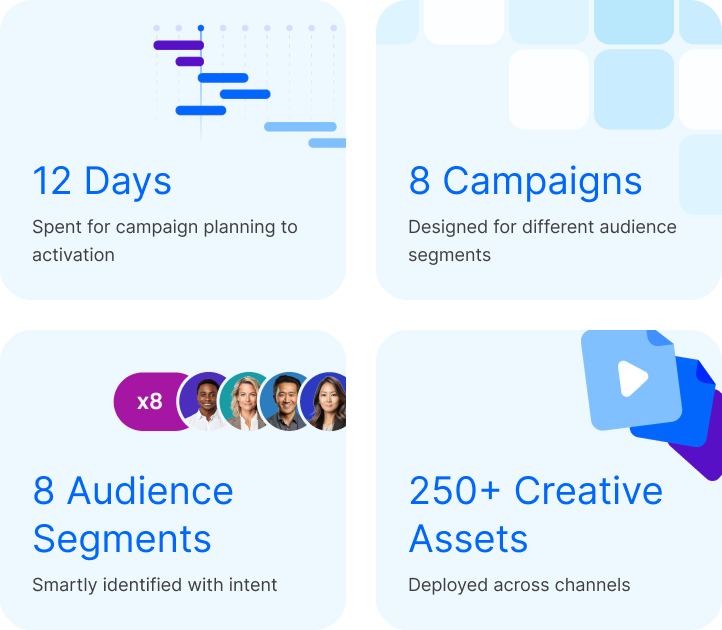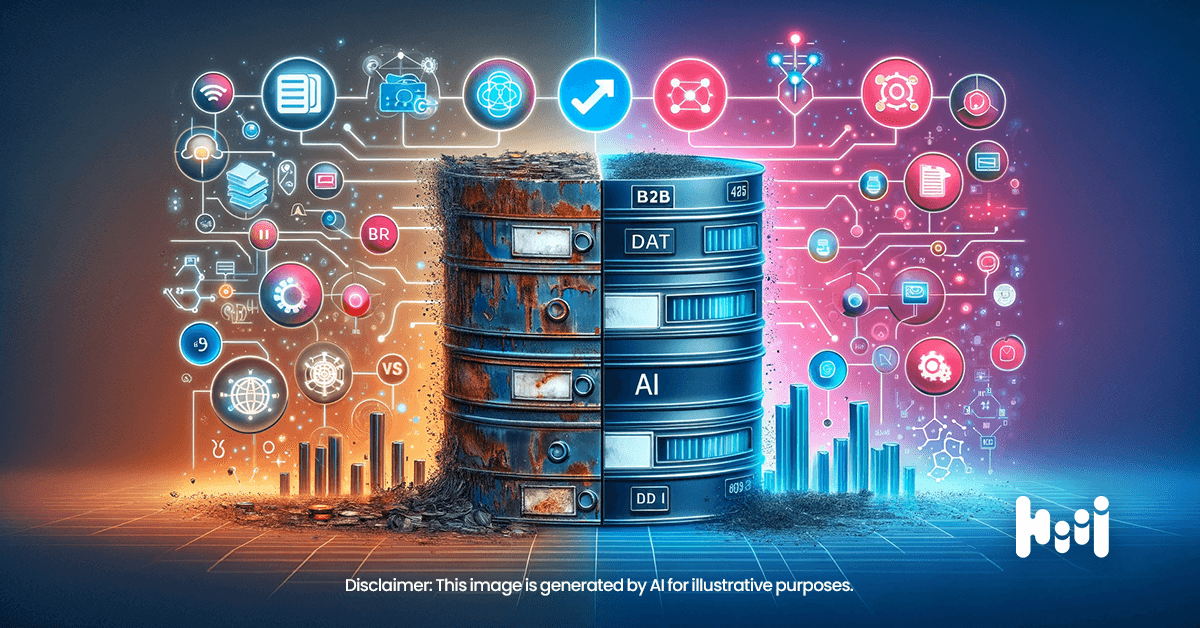
Inside DemandScience’s Customer Zero sprint: how we used our own AI-powered tools to deliver smarter, faster marketing at scale
Twelve days. One full-scale product go-to-market launch. Seven evergreen multichannel campaigns. And more than 250 creative assets across ads, web, content, and product.
This is how we did it, using AI not as a shortcut, but as a true accelerator.

From Vision to Practice
At DemandScience, our vision is simple: help marketers scale smarter through an integrated, AI-powered marketing ecosystem. That means bringing together high-quality data, intelligent targeting, streamlined orchestration, and measurable outcomes.
But we’re not just building this vision for our customers, we’re applying it internally, too. The best way to prove our products and approach? Use them ourselves.

The Challenge
In late June, our team set out to launch a full go-to-market campaign for a new product offering, spanning positioning, product pages, PR, landing experiences, ad creative, and content.
In parallel, we began building seven evergreen, multichannel campaigns, each tailored to a distinct audience segment. These were persona-specific journeys designed to engage different types of B2B buyers across multiple touchpoints, built on firmographic, technographic, and behavioral data. Accounts dynamically flow into each segment when they meet specific triggers or thresholds, ensuring every audience is always up-to-date and in-market.
Every one of these campaigns had to be:
- Fully integrated
- Channel-aligned
- Strategically positioned
- Creative-ready
- QA’d and launch-ready by July 8
We gave ourselves 12 days, not just to launch, but to challenge how fast we could move with AI in the loop.



Our Custom GPT: Content That’s On-Brand From Day One
We started with a custom GPT we’ve been training and evolving since early this year, built specifically to reflect DemandScience’s:
- Product and solution architecture
- Audience personas and buying journeys
- Strategic messaging framework
- Brand voice, tone, and standards
This didn’t happen overnight. Over the past several months, our marketing team has worked with this AI, refining how it understands our brand, our audience journeys, our evolving product architecture, and the nuances of our voice. That training made the AI a real creative partner, not just a writing tool, but an assistant fluent in our context.
This meant the AI understood our structure, language, and intent from the very beginning. We didn’t just feed it prompts, we fed it real context: SME insights, Q&As, sales scripts, and campaign decks.
With that foundation, AI helped us:
- Draft PRs, product pages, landing copy, and modal content
- Generate hundreds of display ad variants within character limits
- Brainstorm CTA language and value-driven headlines
- Check for voice, tone, and structure consistency across formats
Working with AI wasn’t a one-shot process. It was collaborative. We used AI like we would a teammate, brainstorming together, iterating quickly, validating angles, and building cohesion across assets. Copy wasn’t perfect on the first try, but it moved us from concept to draft much faster and more aligned than traditional blank-page starts.
One great example? Display ads. With dozens of creative variants required across channels, each with different character counts, tone, and visuals, we used AI to generate multiple headline and CTA options that respected platform limits while staying on brand. This let our design team focus on layout and clarity while we shaped high-performing messages for each channel.

Intent-Driven Targeting and Personalization
AI didn’t just help us build faster. It helped us build smarter.
We tapped into AI-powered intent signals, driven by NLP and machine learning that analyze content engagement and behavioral patterns, to identify in-market accounts and active buying committees.
With those insights, we personalized the delivery experience, adjusting messaging, content suggestions, and campaign flows based on where each audience was showing interest.
It wasn’t just better targeting. It was better timing, better alignment, and a more responsive campaign engine overall.
The goal? More relevant experiences. Better alignment with actual buyer needs. And campaign flows that respond dynamically to real-time interest, which reflects the kind of orchestration we’re enabling for our customers, too.

Human + AI = Real Acceleration
Let’s be clear: AI didn’t replace our team. It amplified what we could do.
We still had to route content for review. QA landing pages. Vet creative. Stage and test dozens of deliverables. And in a 12-day window, that meant serious hours across strategy, content, digital, design, and product.
This was an all-hands sprint, led by our in-house marketing team, but we moved faster because AI took care of the heavy lifting where it made sense. That’s what made it possible to scale quickly, delivering high volume, cohesion, and quality even under pressure. It accelerated ideation, reduced friction, and let us focus energy on higher-impact work.
Importantly, we also treated AI like a collaborator, not a tool. We shaped inputs with care, reviewed outputs critically, and gave it feedback to refine. Just like we would with a content writer or strategist. This mindset helped us maximize the value without losing quality.
So no, AI didn’t make the work effortless. But it made the timeline, and the scale, possible.



Toward the AI-Powered Marketing Ecosystem
This sprint was just the start. As we continue evolving our campaigns, we’re also beginning to use our own AI-powered orchestration and insight tools to:
- Surface campaign intelligence across stages and segments
- Identify what’s working and what’s underperforming
- Feed data back into our content, creative, and targeting decisions
It’s a closed-loop model, and it’s how we believe modern marketing should work.
We’re also exploring how our internal campaigns can benefit from predictive scoring, real-time segmentation, and automated recommendations, all driven by the same AI backbone we offer our clients. In short: we’re becoming our own best use case, proudly stepping into the role of Customer Zero.
Our customers are looking for more than point solutions. They want to scale with confidence, move faster, and measure what matters. This internal launch was proof that we’re building the infrastructure to support exactly that. And the lessons we’ve gained (and continue to gain) here are helping us shape smarter strategies and faster outcomes for the marketers we partner with every day.

The Takeaway
This wasn’t a case study. It wasn’t a lab experiment. It was a real marketing sprint.
Eight campaigns. 250+ assets. Twelve days. Built with humans and AI working side-by-side.
And it’s only the beginning. These initial launches are now feeding a closed-loop process, powered by our own AI-driven platforms, to surface insights, track performance, and continuously improve every step of the buyer journey.
We’re learning what’s resonating, where to refine, and how to scale even smarter, all by using the same infrastructure we offer our customers.
Faster. Better. Together.
That’s the future of marketing, and we’re building it from the inside out.
Ready to Accelerate Your Next Launch?
Let’s explore how Human+AI can drive smarter, faster campaign execution just like we did.










